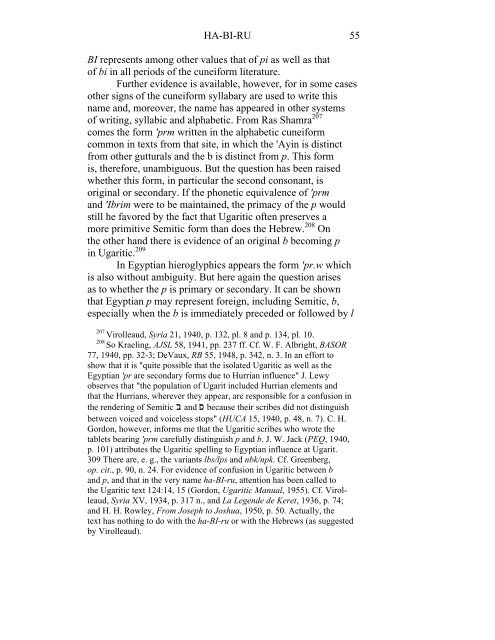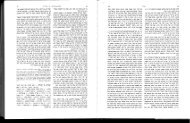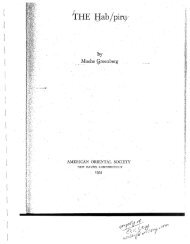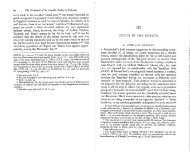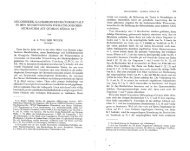The Ha-Bi-Ru--Kin or Foe of Israel? - Gordon College Faculty
The Ha-Bi-Ru--Kin or Foe of Israel? - Gordon College Faculty
The Ha-Bi-Ru--Kin or Foe of Israel? - Gordon College Faculty
Create successful ePaper yourself
Turn your PDF publications into a flip-book with our unique Google optimized e-Paper software.
HA-BI-RU 55<br />
BI represents among other values that <strong>of</strong> pi as well as that<br />
<strong>of</strong> bi in all periods <strong>of</strong> the cuneif<strong>or</strong>m literature.<br />
Further evidence is available, however, f<strong>or</strong> in some cases<br />
other signs <strong>of</strong> the cuneif<strong>or</strong>m syllabary are used to write this<br />
name and, m<strong>or</strong>eover, the name has appeared in other systems<br />
<strong>of</strong> writing, syllabic and alphabetic. From Ras Shamra 207<br />
comes the f<strong>or</strong>m 'prm written in the alphabetic cuneif<strong>or</strong>m<br />
common in texts from that site, in which the 'Ayin is distinct<br />
from other gutturals and the b is distinct from p. This f<strong>or</strong>m<br />
is, theref<strong>or</strong>e, unambiguous. But the question has been raised<br />
whether this f<strong>or</strong>m, in particular the second consonant, is<br />
<strong>or</strong>iginal <strong>or</strong> secondary. If the phonetic equivalence <strong>of</strong> 'prm<br />
and 'Ibrim were to be maintained, the primacy <strong>of</strong> the p would<br />
still he fav<strong>or</strong>ed by the fact that Ugaritic <strong>of</strong>ten preserves a<br />
m<strong>or</strong>e primitive Semitic f<strong>or</strong>m than does the Hebrew. 208 On<br />
the other hand there is evidence <strong>of</strong> an <strong>or</strong>iginal b becoming p<br />
in Ugaritic. 209<br />
In Egyptian hieroglyphics appears the f<strong>or</strong>m 'pr.w which<br />
is also without ambiguity. But here again the question arises<br />
as to whether the p is primary <strong>or</strong> secondary. It can be shown<br />
that Egyptian p may represent f<strong>or</strong>eign, including Semitic, b,<br />
especially when the b is immediately preceded <strong>or</strong> followed by l<br />
207 Virolleaud, Syria 21, 1940, p. 132, pl. 8 and p. 134, pl. 10.<br />
208 So Kraeling, AJSL 58, 1941, pp. 237 ff. Cf. W. F. Albright, BASOR<br />
77, 1940, pp. 32-3; DeVaux, RB 55, 1948, p. 342, n. 3. In an eff<strong>or</strong>t to<br />
show that it is "quite possible that the isolated Ugaritic as well as the<br />
Egyptian 'pr are secondary f<strong>or</strong>ms due to Hurrian influence" J. Lewy<br />
observes that "the population <strong>of</strong> Ugarit included Hurrian elements and<br />
that the Hurrians, wherever they appear, are responsible f<strong>or</strong> a confusion in<br />
the rendering <strong>of</strong> Semitic b and p because their scribes did not distinguish<br />
between voiced and voiceless stops" (HUCA 15, 1940, p. 48, n. 7). C. H.<br />
G<strong>or</strong>don, however, inf<strong>or</strong>ms me that the Ugaritic scribes who wrote the<br />
tablets bearing 'prm carefully distinguish p and b. J. W. Jack (PEQ, 1940,<br />
p. 101) attributes the Ugaritic spelling to Egyptian influence at Ugarit.<br />
309 <strong>The</strong>re are, e. g., the variants lbs/lps and nbk/npk. Cf. Greenberg,<br />
op. cit., p. 90, n. 24. F<strong>or</strong> evidence <strong>of</strong> confusion in Ugaritic between b<br />
and p, and that in the very name ha-BI-ru, attention has been called to<br />
the Ugaritic text 124:14, 15 (G<strong>or</strong>don, Ugaritic Manual, 1955). Cf. Virol-<br />
leaud, Syria XV, 1934, p. 317 n., and La Legende de Keret, 1936, p. 74;<br />
and H. H. Rowley, From Joseph to Joshua, 1950, p. 50. Actually, the<br />
text has nothing to do with the ha-BI-ru <strong>or</strong> with the Hebrews (as suggested<br />
by Virolleaud).


